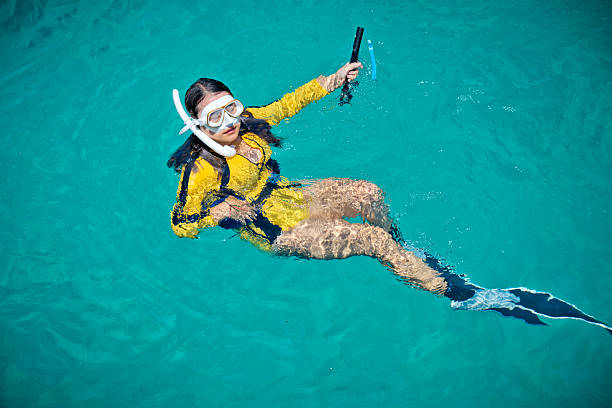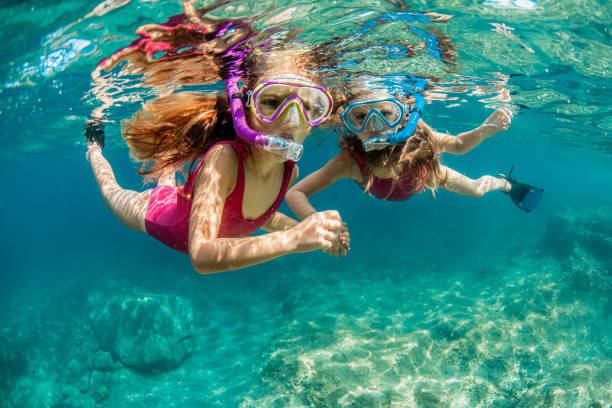Finding the right freediving mask factory can feel complex. You might already have a product concept, or you may be looking to improve an existing line. In either case, the factory you work with directly impacts the quality, reliability, and long-term performance of your masks. If you’re still unsure where to start, you’re in the right place!
This guide will walk you through seven clear steps. By following these steps, you’ll gain the insight and confidence needed to assess a factory effectively and avoid costly mistakes. Whether you are looking for the best freediving mask factory or a wholesale freediving mask supplier, these steps will help you make an informed decision.
Step 1: Define Clear Product Specifications
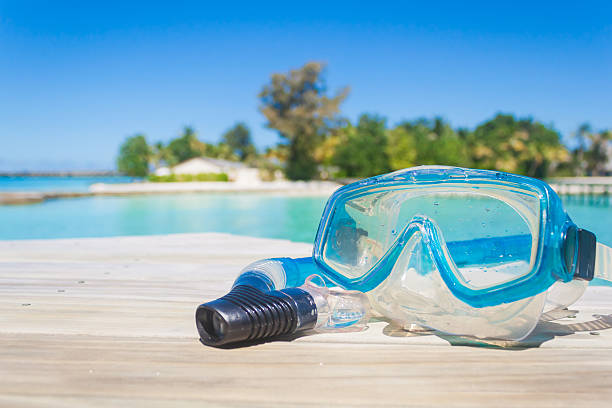
Before talking to any factory, you need a full and structured product brief. A factory can only produce a world-class قناع الغوص الحر when you tell them what “world-class” means to you.
Start with core functional requirements.
A freediving mask works best when its internal volume stays low, usually between 65–90 ml for competitive-style models. If you want deeper dives or less need for equalization, state the volume target clearly. Some factories can design within very tight volume limits, but others struggle to shape the internal cavity without affecting comfort. At this stage, finding a custom diving mask partner with experience in low-volume designs is essential.
Describe the lens structure and material.
Most high-end masks use tempered glass for better clarity and durability. However, for ultra-light or youth models, polycarbonate lenses may offer cost savings. If you aim for premium performance, double-coated glass lenses improve scratch resistance by around 15–25% during long-term use.
Explain your skirt expectations.
The skirt affects the seal and long-term comfort. Many factories use silicone with a Shore A hardness around 35–45, which works for most face shapes. If you target a specific market with narrower or wider facial profiles, tell the factory what you need. Even a 2–3 mm change in skirt thickness can change how the mask sits on the face.
Add color, packaging, and compliance needs.
Even if it feels simple, list them. Colors, strap design, logos, anti-UV requirements, REACH or RoHS compliance. These details help factories plan materials and reduce errors later. A freediving mask manufacturer that can accommodate all these custom requirements will save you time and frustration.
Step 2: Evaluate Samples for Quality and Fit
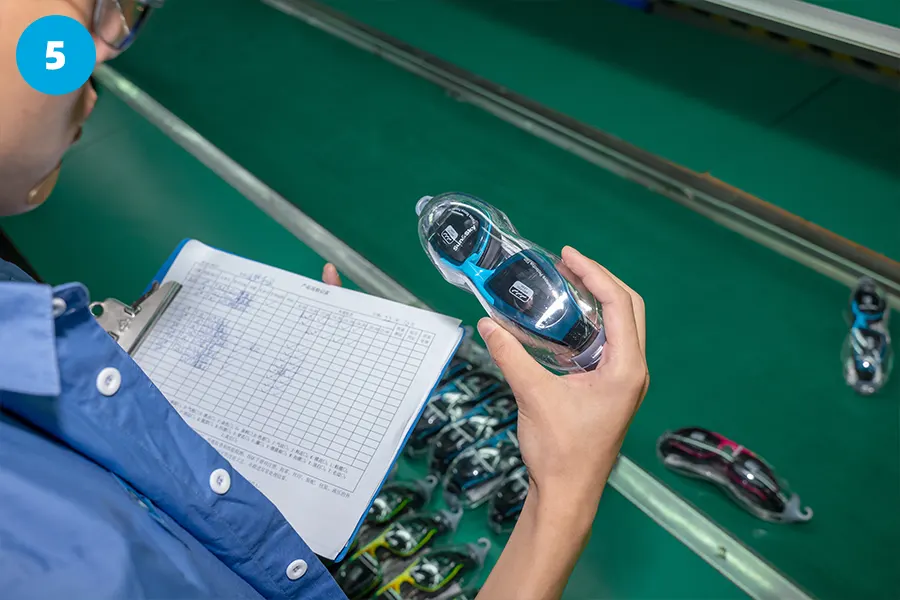
A sample reveals whether a factory truly understands freediving mask engineering or is merely repurposing a scuba mask mold. Focus on the following key points:
- Frame and Lens Alignment
- Check for warping, uneven edges, or visible gaps.
- Any gap above 0.2 mm may cause leaks at depth.
- Ensure the lens sits securely and evenly in the frame.
- Check for warping, uneven edges, or visible gaps.
- Skirt Softness and Seal
- Press along the silicone skirt to check flexibility and shape recovery.
- Soft but stable skirts prevent water entry and improve equalization.
- Look for consistent hardness; uneven softness can compromise comfort.
- Press along the silicone skirt to check flexibility and shape recovery.
- Field of View (FOV)
- Assess horizontal and vertical angles.
- High-quality masks typically offer 82–95° horizontal FOV.
- Limited FOV reduces visibility during critical descent or safety checks.
- Assess horizontal and vertical angles.
- Long-Term Comfort
- Wear the mask for 10–15 minutes.
- Check for pressure points on cheekbones or nose bridge.
- Uneven strap tension or early discomfort indicates poor design.
- Wear the mask for 10–15 minutes.
- Consistency Across Multiple Samples
- Compare at least two pieces from the same batch.
- Differences reveal molding or QC inconsistencies.
- Stable factories produce near-identical samples.
- Compare at least two pieces from the same batch.
- Stress and Flexibility Tests
- Lightly twist or stretch the skirt.
- Mask should return to original shape without whitening or deformation.
- Ensures long-term durability under repeated use.
- Lightly twist or stretch the skirt.
Step 3: Confirm Manufacturing Capacity with Evidence
Check Their Equipment
Look at their injection molding machines and silicone processing systems. For quality freediving masks, machines usually range from 120–250 tons. Ask about their maintenance schedule and machine age. At سباحة الطليعة, for example, we maintain a fleet of modern injection machines and silicone de-aerators, ensuring every mask we produce matches strict volume and shape specifications.
Review Their Mold Inventory
Ask how many silicone skirt molds and frame molds they have. A well-prepared factory typically keeps 30+ skirt molds and 10–20 frame molds ready. This shows they can manage multiple product lines and keep your production stable. If they only have a few molds, your batch may face delays or inconsistencies.
Observe the Production Flow
Walk or virtually tour the production floor. Check whether injection, trimming, assembly, testing, and packaging areas are organized. Clear separation of tasks usually means fewer mistakes. Crowded or mixed areas often lead to quality issues.
Ask for Real Output Data
Don’t rely on promises. Ask for past production records: monthly output, peak-season capacity, and on-time delivery rates. If a factory is transparent, you’ll get a realistic sense of whether they can meet your deadlines. This step is especially important if you plan to order wholesale freediving masks.
Step 4: Check QC Systems and Testing Procedures

QC Systems
A strong QC system shows how seriously a factory treats consistency. Ask about how they monitor quality at every stage:
- Incoming Material Inspection (IQC): Every batch of silicone, lenses, and straps should be checked for compliance with your specifications. At Vanguard Swimming, we measure silicone hardness, check lens coatings, and verify strap tensile strength before production starts.
- In-Process QC (IPQC): This ensures that assembly and molding stay consistent. Masks are inspected after injection, after skirt trimming, and during frame assembly. You should confirm whether the factory has checkpoints like these in place.
- Final Product QC (FQC): Even minor defects can affect performance at depth. A proper final inspection evaluates seal integrity, lens alignment, and skirt flexibility before packaging.
- Traceability: Ask if they track molds, material batches, and individual production runs. Vanguard maintains a full traceability system, so we can quickly identify and address any issues that arise in a batch.
Testing Procedures
Testing goes beyond visual checks. You need to ensure every mask meets functional requirements:
- Leak and Pressure Tests: Masks should be tested under simulated depth pressure. At Vanguard, we run pressure simulations equivalent to 30 meters of water depth to verify the seal holds without deformation.
- Skirt Flexibility and Adhesion Tests: Evaluate how well the skirt returns to shape and how firmly the lens is bonded to the frame. These tests ensure comfort and durability over repeated dives.
- Strap Tensile Strength: Straps must withstand at least 12–15 kg of tension without breaking or slipping.
- Optical and Lens Clarity Tests: Check for warping, distortions, or coating defects that could reduce visibility.
- Thermal and Environmental Resistance: Silicone and lens materials should maintain shape and clarity under varying temperatures and humidity.
Step 5: Assess OEM/ODM and R&D Capabilities
Start by evaluating the factory’s engineering resources. Ask about their product designers, mold engineers, and testing specialists. Experienced teams can adjust skirt hardness, frame curvature, and internal volume to suit different facial structures and diving depths. They should also be able to create prototypes efficiently and refine designs based on performance testing.
Next, consider their track record with custom projects. Reliable factories produce multiple new models each year, maintain clear development timelines, and document mold and material data. They should provide you with sample prototypes, 3D design files, and testing feedback so you can evaluate performance before committing to bulk production. Key capabilities to check include:
- Material adjustments: Ability to optimize silicone hardness or dual-density skirts
- Volume tuning: Fine control of internal mask volume for low- or high-volume dive mask designs
- التصميم الهيدروديناميكي: Frame and lens shaping to reduce drag and improve vision
- Prototype iteration: Fast turnaround and precise reproduction of design changes
Step 6: Review Pricing, MOQs, and Lead Times
While cost matters, you should also weigh quality, R&D support, and production reliability. The table below highlights the key points to check:
| عامل | What to Check | Industry Benchmark |
| Pricing | Material grade, mold cost, labor, QC, lens type | Mid-to-high range for low-volume masks due to precision requirements |
| الحد الأدنى لكمية الطلب | Minimum units per order | 300–500 pcs for standard masks; 800–1,000 pcs for custom colors; 1,200+ pcs for fully custom molds |
| Lead Time | Time from order confirmation to shipment | 35–55 days for regular models; 55–75 days for customized models; 90+ days with new molds |
| Cost vs Quality Trade-off | Be cautious of extremely low quotes | Price far below market usually indicates shortcuts in materials or QC |
Step 7: Validate the Supplier with Audits and Trial Orders
Even the most promising factory on paper may hide issues you can only see in practice. To ensure reliability, start with a supplier audit. You can conduct it on-site or virtually. During the audit, focus on key areas:
- Raw material storage: Are silicone, lenses, and straps stored properly to prevent contamination or degradation?
- Mold management: Are molds organized and maintained regularly?
- Silicone mixing and processing: Check for consistency and proper handling.
- Worker skill and workflow: Experienced staff move efficiently and handle materials carefully.
- Equipment maintenance: Machines should have clear maintenance records.
- Final testing stations: Inspect whether QC checks are properly set up and followed.
Next, observe the production of an actual batch. Pay attention to how workers handle skirt edges, lens alignment, and buckles. Smooth, confident workflow and organized stations are strong indicators of a capable factory.
Finally, place a small trial order of 100–300 units. This is often the best way to see real performance. You need to check:
- Skirt finish consistency
- Color matching
- Deformation or warping after packing
- Adequacy of shipping protection
- Batch-to-batch consistency
What Is a Good Freediving Mask Manufacturer?
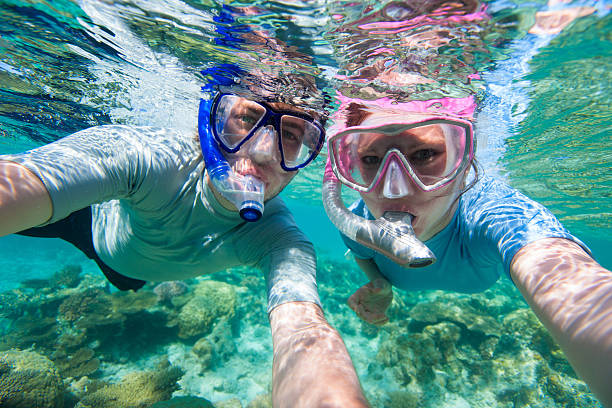
After walking through the key steps of choosing a reliable freediving mask factory, you might still wonder what a truly top-tier partner looks like in real life. A reliable freediving mask manufacturer should offer stable quality, strong engineering support, and a production system you can trust. If you’re searching for a partner that helps you grow your product line with confidence, سباحة الطليعة checks all the boxes — and more.
Production Strength You Can Count On
- One-stop manufacturing that covers material selection, mold development, injection molding, assembly, and final inspection.
- Strict in-house quality control with consistent testing for pressure resistance, skirt sealing, and long-term durability.
- Scalable capacity suitable for both medium and high-volume orders, helping your business expand steadily.
Product Advantages That Make a Difference
- Low-volume and ultra-low-volume mask designs that reduce equalization effort and improve hydrodynamics.
- High-grade liquid silicone skirts for a soft, secure, and leak-free fit.
- Tempered-glass lenses with wide-angle visibility for recreational and advanced freedivers.
Custom Options Designed for Your Market
- Support for custom molds, private labeling, and OEM/ODM development.
- Color matching, strap redesign, lens shape adjustment, and branding features tailored to your audience.
- Engineering guidance that helps you refine function, comfort, and aesthetic appeal.
Service That Helps You Grow
- Fast communication and transparent timelines so you always know where your order stands.
- Sample optimization support to help you fine-tune your final product.
- Long-term partnership mindset focused on helping you build a strong, sellable product line.
Build Long-Term Value with Vanguard Swimming
After carefully evaluating freediving mask factories, you now understand what it takes to ensure consistent quality, reliable production, and optimized performance. Choosing the right partner is about building long-term value for your brand and your customers.
سباحة الطليعة is designed to be that partner. As a professional freediving mask manufacturer, we combine advanced production capabilities with expert design and quality control, helping you bring high-performance products to market efficiently.
Ready to elevate your freediving mask lineup?
اتصل بنا اليوم to explore our one-stop manufacturing solutions and custom services.
